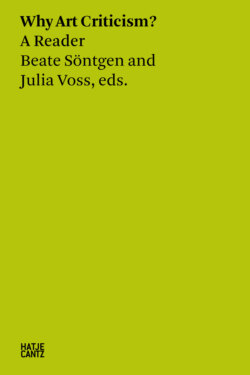Читать книгу Why Art Criticism? A Reader - Группа авторов - Страница 22
ОглавлениеSergei Tretyakov
Sergei Tretyakov (1892–1937) has a reputation as one of the most active and versatile members of the avant-garde of the nineteen-twenties and thirties in the Soviet Union. He has frequently been characterized as a poet, author, photojournalist, and travel writer, and he also worked on several cinematic productions. Yet little attention has hitherto been paid to his activity as an art critic. His art criticism is particularly interesting, however, because these writings were formulated under new political conditions and in the expectation that every field would break with tradition. At the same time, Tretyakov’s art criticism reflects his conceptual and political thinking and his participation in various artistic movements, and these influenced the character of his style and terminology.
In the post-revolutionary climate of the Soviet Union, art criticism acquired a new function. Alexander Bogdanov, the theoretician behind the Proletkult implemented by the Bolshevik Party, ascribed it a steering, regulating role in Iskusstvo i rabochiy klass (art and the working class), a volume published in 1919. He also argued there that art criticism should see its primary task as defining the boundaries of proletarian art to prevent its contamination by the art of the “old world.” In keeping with this aim, Soviet art criticism began to acquire the character of art theory in the early twenties. In a similar vein, the two selected texts by Tretyakov exemplify how early Soviet art criticism turned away from bourgeois society and the art market as traditional addressees. They affirm the goals of the socialist revolution and pursue a politically driven program. They instruct, agitate, and with the aid of rhetorical devices such as metaphor and short questions convey the dynamism and determination of the twenties in the Soviet Union.
The magnitude of the project to which the proponents of the artistic avant-garde had subscribed is illustrated by a book published with writer Nikolai Aseyev in the Siberian city of Chita in 1922, which devotes 26 pages to the Cubo-Futurist painter Viktor Palmov. Tretyakov does not confine his thoughts here to the work of Palmov, or to urban centers such as Moscow and Saint Petersburg, but extends them to the development of painting up to and including the transformation of the entire realm of art and the role of the artist. At the end of his text, Tretyakov draws on the widespread vocabulary of war to portray the current situation in art: here art is a “front line” where forces advance, attack, and engage in battle, just like a military avant-garde. Since 1913, Tretyakov had been an active member of Futurist groups and doubtless saw himself as part of this “artistic combat.”
In 1923 in Moscow, he joined with Vladimir Mayakovsky, photographer Alexander Rodchenko, and others to found the Left Front of the Arts (LEF). Its print media—the journal Lef (1923–25) and later Novyi Lef (1927–29)—offered the group an opportunity for experiments and the conception of what became known as “factography,” an artistic strategy for using words and photography to document reality. Factography was intended to ensure maximum authenticity and to agitate through the montage of diverse “facts.” Tretyakov’s “Photo Notes” of 1928 can be read within the context of Novyi Lef objectives. As a basis, he draws on his own facts—travel jottings, diary, reportage, or anything directly recorded—and on his own person as a photographer. He integrates dialogues with amateur photographers, describes moments in factories, and “assembles” these to endorse his line of argument. In reflecting on the methods of photography, therefore, he was testing a concept he championed: the “literature of fact.” The text demonstrates how art criticism can itself become a field for literary experiment.
